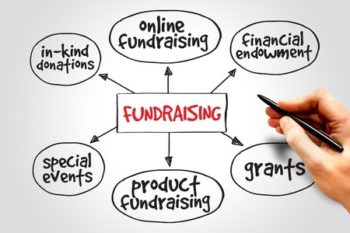Leading Nonprofit Fundraising Ideas: Innovative Techniques to Raise More Funds
Leading Nonprofit Fundraising Ideas: Innovative Techniques to Raise More Funds
Blog Article
The Duty of Area Engagement in Nonprofit Fundraising: Building Lasting Relationships for Sustainable Support
Community interaction is increasingly recognized as a vital element of successful nonprofit fundraising. By fostering genuine partnerships with neighborhood stakeholders, companies can cultivate depend on and commitment, which are necessary for lasting assistance. However, the methods and techniques utilized to involve neighborhoods differ widely, increasing important questions regarding efficiency and influence. What are the very best techniques for cultivating these vital connections, and how can nonprofits measure their success in this sector? Comprehending these characteristics could dramatically affect the future of fundraising initiatives and the general objective of not-for-profit companies.
Recognizing Area Engagement
Area engagement is a crucial element of successful not-for-profit fundraising initiatives. Nonprofits should determine crucial stakeholders-- such as community participants, local services, and other organizations-- to create effective engagement techniques.
Reliable neighborhood engagement is based on energetic listening and responsiveness to the requirements and interests of the area. This process involves soliciting feedback, understanding community dynamics, and ensuring that the company's mission aligns with regional top priorities. Involving the neighborhood can take various types, consisting of public conferences, volunteer chances, and collaboration campaigns, each made to urge involvement and investment in the organization's goals.
Moreover, community interaction should be approached as a continuous discussion instead of a single effort. By fostering a comprehensive setting where community voices are listened to and valued, nonprofits can develop a strong foundation for future fundraising undertakings. Eventually, a deep understanding of community involvement empowers companies to create genuine links that boost their general effectiveness and sustainability.
Advantages of Solid Relationships
Solid partnerships created with neighborhood engagement yield numerous benefits for not-for-profit fundraising efforts. Most importantly, these connections foster depend on and credibility, crucial components in motivating contributors to add. When potential supporters see a not-for-profit actively associated with their community, they are a lot more most likely to rely on its goal and impact.

In addition, these connections assist in reliable communication. Nonprofits can utilize their connections to share stories of influence, updates, and needs, making certain that advocates continue to be educated and involved. This open line of interaction not only strengthens bonds but also motivates referral promotion, expanding the nonprofit's reach.
Last but not least, solid neighborhood connections can bring in new companions and sponsors. People and businesses are more likely to line up with companies that show purposeful neighborhood participation, providing extra sources and assistance that can substantially boost fundraising capacities. Hence, cultivating robust relationships through area engagement is important to a nonprofit's long-lasting fundraising success.
Strategies for Efficient Involvement
Just how can nonprofits successfully engage their communities to improve fundraising initiatives? Regular updates, engaging web content, and calls-to-action can galvanize community rate of interest and participation.
Second, hosting community events, such as workshops, volunteer possibilities, or fundraising drives, helps with face-to-face interaction, allowing nonprofits pop over to these guys to showcase their effect and initiatives. These occasions not just increase funds but additionally grow connections and permit area members to engage directly with the cause.
Third, implementing individualized interaction techniques can enhance interaction. Customizing messages to certain contributor sectors based on interests and past payments fosters a feeling of belonging and investment in the company's objective.
Last but not least, creating partnerships with neighborhood businesses and area leaders can magnify outreach initiatives. Collective efforts can improve presence and reputation, showing a cumulative dedication to the area's wellness. By incorporating these methods, nonprofits can build lasting partnerships that enhance fundraising initiatives and drive lasting support.
Measuring Involvement Success
While involving the neighborhood is vital for effective not-for-profit fundraising, gauging the efficiency of these engagement efforts is equally crucial. Establishing clear metrics permits organizations to analyze exactly how well they are getting in touch with their target market and attaining their fundraising goals. Trick performance signs (KPIs) such as donor retention prices, volunteer engagement degrees, and involvement on social media systems offer concrete information for analysis.

Consistently analyzing these metrics makes it possible for organizations to pivot their methods when needed, guaranteeing that neighborhood involvement stays straightened with their total mission. Furthermore, sharing these outcomes with stakeholders cultivates transparency and develops depend on, encouraging additional area participation. Eventually, a robust dimension framework not only informs future fundraising initiatives but likewise enhances the relationship in between the nonprofit and its advocates, preparing for lasting success.
Study in Neighborhood Effect
Countless study highlight the extensive effect that neighborhood interaction can have on not-for-profit fundraising success. One significant example is the "Something to chew on" great post to read initiative, where a regional food bank partnered with organizations and colleges to host neighborhood suppers. These occasions not just elevated funds however additionally fostered a feeling of belonging among participants, considerably enhancing benefactor retention rates.
One more compelling situation is the "Green Spaces Task," which involved regional homeowners in the revitalization of city parks. This initiative not just gathered financial backing from neighborhood organizations but also grew a volunteer base that added to ongoing maintenance and shows. The sense of ownership and pride among area members converted into continual contributions.
In the world of arts, the "Art for All" project successfully engaged neighborhood musicians and customers to create collaborative art installations, leading to enhanced visibility and donations for a regional arts not-for-profit.
These instances highlight that when nonprofits focus on neighborhood involvement, they can develop enduring partnerships that boost fundraising initiatives, making certain lasting assistance and cultivating a vivid area culture. Such instances show that neighborhood interaction is not just a strategy yet an essential pillar of not-for-profit success.
Conclusion
In conclusion, neighborhood engagement is integral to the success of not-for-profit fundraising efforts. By fostering solid partnerships with regional stakeholders, organizations boost depend on and integrity, resulting in improved contributor retention and loyalty. Carrying out efficient involvement methods and measuring their effect ensures that nonprofits can grow and adjust. Inevitably, a durable foundation of neighborhood support not only amplifies fundraising useful source prospective yet additionally grows a culture of partnership, vital for accomplishing lasting organizational objectives and sustaining significant influence.
Nonprofits need to identify essential stakeholders-- such as neighborhood members, regional businesses, and various other companies-- to create efficient interaction strategies.

In conclusion, community involvement is essential to the success of not-for-profit fundraising initiatives.
Report this page